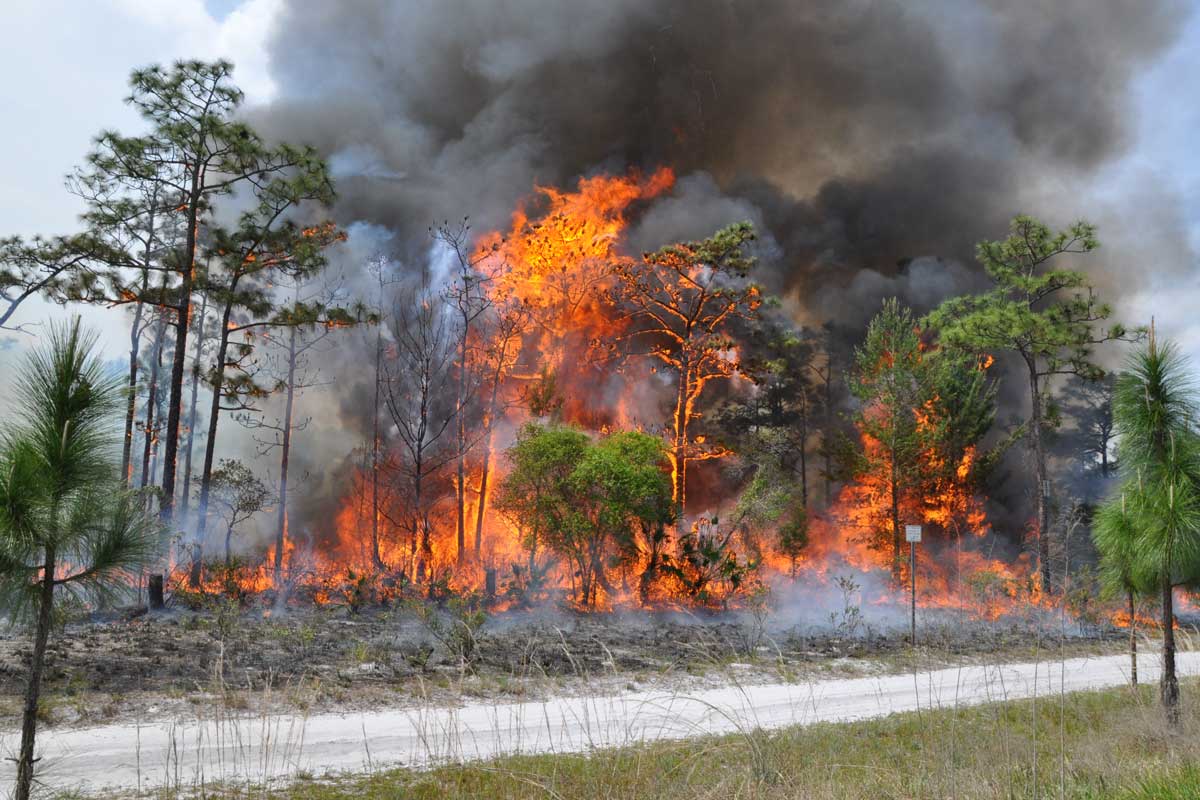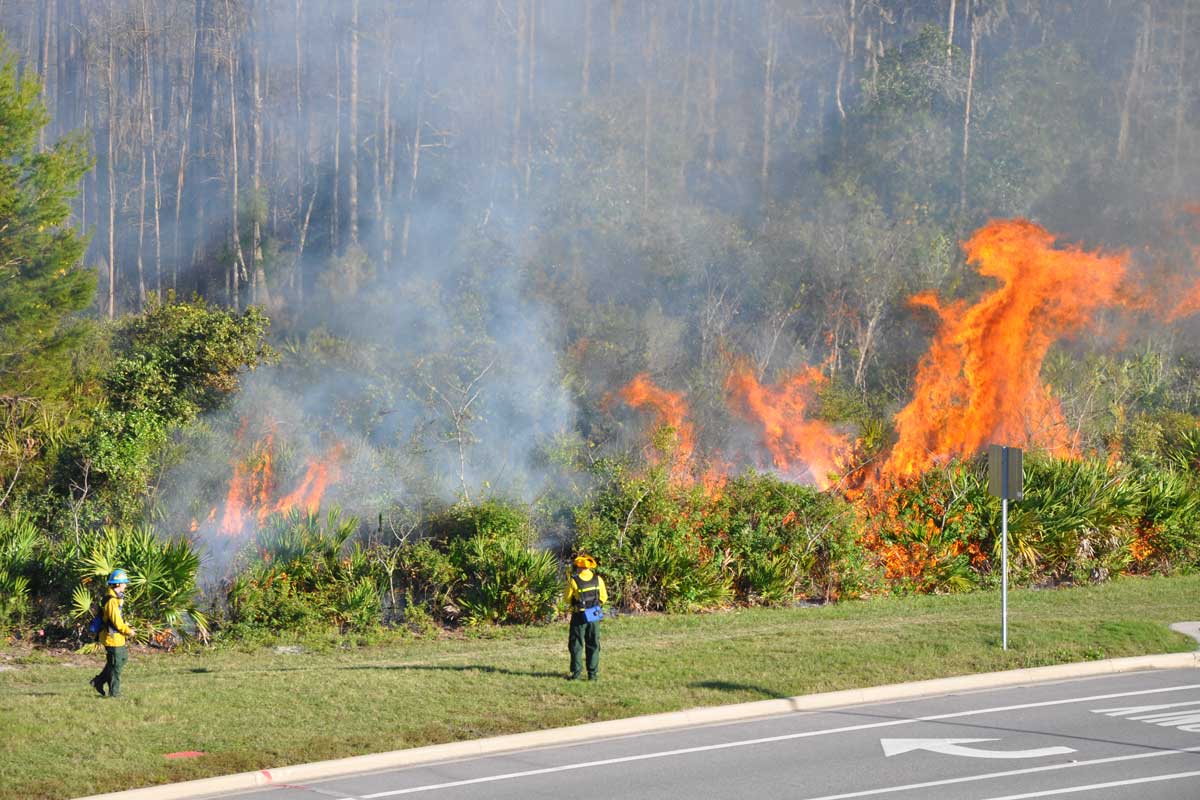From December through June, visitors to UCF’s main campus may occasionally see large, orange flames licking at trees and incinerating plants near recreational grounds, parking garages or student housing. The scene appears much scarier than what’s actually occurring.
These months of the year are UCF’s burn season, which is overseen by the UCF Landscaping and Natural Resources program. Raymond Jarrett ’98 is a coordinator for the team and a certified arborist with the International Society of Arboriculture. He earned his degree in biology from UCF.
One of his job duties is to reduce the threat of wildfires on campus similar to those recently in California or currently in Australia. Just how does his team ensure campus safety? It’s simple — they fight fire with fire.
Why would you start a fire in order to prevent one?
Most of these ecosystems are fire dependent or fire influenced habitats, which should naturally experience fire on a regular basis.
We do prescribed burning for two main reasons: habitat improvement and public safety. UCF is roughly a 1,500-acre campus and almost half of it is still undeveloped and natural, especially on the north and east side. Most of these ecosystems are fire dependent or fire influenced habitats, which should naturally experience fire on a regular basis. But due to fragmentation, roadways and development, natural fires don’t occur on the frequency that they should. So we reintroduce fire to these type of habitats that are dependent on it. It’s important to us at UCF because there are subdivisions to the north and east that border our natural lands and we want to do all we can to keep our campus community and neighbors safe.
What does a prescribed burn do?
It helps burn down the heavy fuel — the vegetation — that builds up over time. The more frequently you burn it, the less of a chance you will have a wildfire risk. And if a wildfire risk takes effect, if the lands are maintained on a regular basis with prescribed burns, the wildfire is not as intense and easier to combat and control.
How do you know when to do a burn?
The burns are very weather dependent. We actually write a prescription that’s approved by the Florida Forest Service. We did a burn on Jan. 7 on four acres near Lake Claire in an area that has not seen fire in probably 50 years. It had no fire history that we know of. We waited for a cold front to come through because cold fronts often have rain out ahead of them. Two or three days after the front, you usually have a very steady predictable wind. Our prescriptions are written so that we have good steady, controllable winds with high dispersion so that smoke lifts up and out and it allows us to control the fire.

When did UCF start doing burns?
We had a very bad wildfire in 2004 that was started by a lightning strike on the corner of Orion and Gemini boulevards across from Garage D. It took off and they had to close that part of campus down and it was pretty catastrophic. The following year, UCF administration reached out to the Arboretum and asked how can we mitigate this? That started our fire program.
What are we seeing in Australia right now?
The last three or four years they have had record hot summers. During their dry season, because they have such vast land, you get these drought years where wildfires are more intense. We’ve had those in Florida, especially in 1998. We were in a very, very dry year with very high temperatures and when the lightning season started, it just lit off fires everywhere. It was pretty catastrophic across the state. It’s similar for Australia. In California, you add on the Santa Ana winds, which can exceed 40 miles per hour, and a fire can just blow through a habitat within minutes with that kind of speed.
When a wildfire destroys habitat like in Australia or California, what can be done to help rebuild the natural landscape?
That same intersection on campus where the wildfire broke out in 2004 – we did a prescribed burn in there about a year and a half ago. It completely blacked out the site. It killed all the ground covers and shrubs. After we did that burn we got a lot of complaints. Six months later, that whole area was covered in wildflowers and new pines were regenerating. This habitat loves fires. It might look black right after, but they actually come back stronger and with more biodiversity and native plants. If you don’t burn it, the saw palmetto and the woody vegetation grows and grows and begins to shade out the groundcovers that are very important for that ecosystem. Burning out that layer helps them grow back bigger and better.
Why don’t more places do controlled burns?
In Florida and the Southeast United States, you have a lot of flat land, and so this region has been very successful introducing prescribed fire to these ecosystems to help reduce the threat of wildfire. California is very well developed with a lot of agricultural lands and a lot of home sites built on hills and mountains. Doing a prescribed burn on flat lands compared to a hill is completely different. When you start a fire on a hill, it will run up that hill within seconds. So it makes it very difficult to do prescribed burning in California, but they have been slowly trying to reintroduce it.





